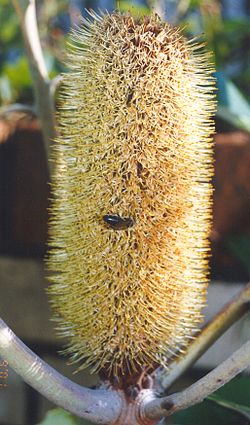Banksia robur
| Habit | shrub
| |
|---|---|---|
| Height: | ⇕ | 10 ft"ft" can not be assigned to a declared number type with value 10. |
| Width: | ⇔ | 7 ft"ft" can not be assigned to a declared number type with value 7. |
| Lifespan: | ⌛ | perennial |
| Origin: | ✈ | Australia |
| Bloom: | ❀ | early summer, mid summer, late summer, early fall, mid fall, late fall, early winter, mid winter, late winter |
| Exposure: | ☼ | sun |
|---|---|---|
| Water: | ◍ | moderate, dry |
| Features: | ✓ | flowers, cut flowers |
| USDA Zones: | 9 to 10.5 | |
| Flower features: | ❀ | yellow |
|
Banksia > |
robur > |
Banksia robur, commonly known as Swamp Banksia or, less commonly, Broad-leaved Banksia grows in sand or peaty sand in coastal areas from Cooktown in north Queensland to the Illawarra region on the New South Wales south coast. It is often found in areas which are seasonally inundated.
Banksia robur is a spreading shrub to 2.5 m (8 ft), although can get a little larger in cultivation. It has very large, leathery tough green leaves with serrated margins up to 30 cm (12 in) long and 10 cm (4 in) wide. The new growth is colourful, with shades red, maroon or brown with a dense felt-like covering of brown hairs.
Plants from different areas seem to flower at different times, some spring-summer, others predominantly autumn. The stunning large flower spikes, up to 15cm high and 5-6cm wide, are metallic green with pinkish styles in bud, becoming cream-yellow and fading to golden-brown.In the golden stage. The old flowers turn grey and persist on old cones, concealing the small follicles. These follicles are reddish and furred when new, before fading. The plant is lignotuberous, regenerating from the ground after fire.
Cultivation
Propagation
Pests and diseases
Varieties
Hybrids with its close relative, B. oblongifolia (Fern-leaved Banksia) can be sometimes found where both species occur (such as near Bulli in the Illawarra), with features intermediate between both species.
Gallery
References
External links
- w:Banksia robur. Some of the material on this page may be from Wikipedia, under the Creative Commons license.
- Banksia robur QR Code (Size 50, 100, 200, 500)


